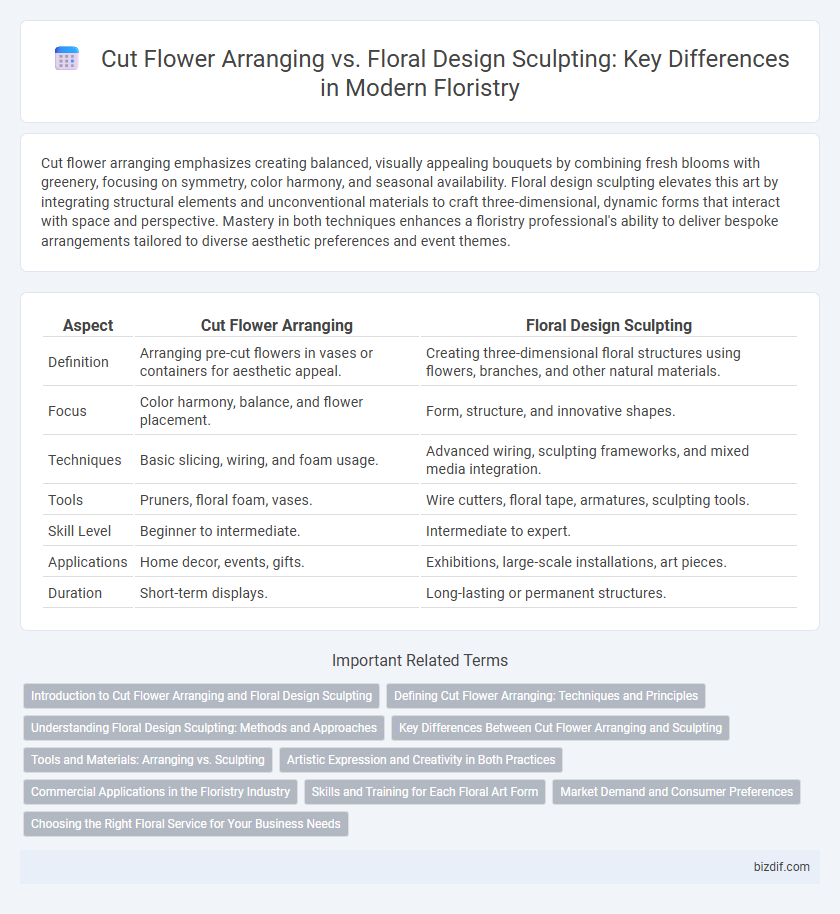Cut flower arranging emphasizes creating balanced, visually appealing bouquets by combining fresh blooms with greenery, focusing on symmetry, color harmony, and seasonal availability. Floral design sculpting elevates this art by integrating structural elements and unconventional materials to craft three-dimensional, dynamic forms that interact with space and perspective. Mastery in both techniques enhances a floristry professional's ability to deliver bespoke arrangements tailored to diverse aesthetic preferences and event themes.
Table of Comparison
| Aspect | Cut Flower Arranging | Floral Design Sculpting |
|---|---|---|
| Definition | Arranging pre-cut flowers in vases or containers for aesthetic appeal. | Creating three-dimensional floral structures using flowers, branches, and other natural materials. |
| Focus | Color harmony, balance, and flower placement. | Form, structure, and innovative shapes. |
| Techniques | Basic slicing, wiring, and foam usage. | Advanced wiring, sculpting frameworks, and mixed media integration. |
| Tools | Pruners, floral foam, vases. | Wire cutters, floral tape, armatures, sculpting tools. |
| Skill Level | Beginner to intermediate. | Intermediate to expert. |
| Applications | Home decor, events, gifts. | Exhibitions, large-scale installations, art pieces. |
| Duration | Short-term displays. | Long-lasting or permanent structures. |
Introduction to Cut Flower Arranging and Floral Design Sculpting
Cut flower arranging involves skillfully selecting and positioning fresh blooms to create balanced, visually appealing compositions that highlight natural beauty and color harmony. Floral design sculpting emphasizes artistic creativity by shaping flowers and foliage into three-dimensional structures, often incorporating unconventional materials for dynamic visual impact. Both techniques require understanding floral mechanics, design principles, and plant material longevity.
Defining Cut Flower Arranging: Techniques and Principles
Cut flower arranging involves selecting, trimming, and organizing fresh blooms to create visually appealing compositions, emphasizing balance, color harmony, and focal points. Techniques include proper stem cutting angles to enhance water uptake, conditioning flowers for longevity, and using floral foam or containers to support structure. Principles focus on proportion, rhythm, and unity, ensuring each arrangement reflects natural beauty and seasonal availability.
Understanding Floral Design Sculpting: Methods and Approaches
Floral design sculpting emphasizes three-dimensional forms and structural artistry, contrasting with the flat, bouquet-focused approach of cut flower arranging. Techniques such as wiring, taping, and using floral foam enable designers to create dynamic shapes and intricate compositions that highlight texture and balance. Mastery of spatial awareness and material manipulation is essential for producing sculptural floral arrangements that serve as focal points in interior or event decor.
Key Differences Between Cut Flower Arranging and Sculpting
Cut flower arranging emphasizes the balanced placement of blooms in vases or containers to create visually appealing displays, prioritizing color harmony and natural forms. Floral design sculpting involves shaping flowers and plant materials into three-dimensional structures, often incorporating wireframes or unusual elements to craft intricate, artistic compositions. The key differences lie in arranging's focus on traditional, symmetrical aesthetics versus sculpting's innovative, structural, and often abstract approach.
Tools and Materials: Arranging vs. Sculpting
Cut flower arranging primarily relies on floral foam, wire cutters, and floral tape to create balanced, traditional bouquets emphasizing color and form harmony. Floral design sculpting involves specialized tools such as floral knives, adhesives, and armatures to manipulate materials into three-dimensional, innovative structures that challenge conventional floral aesthetics. Both disciplines utilize fresh flowers and foliage, but sculpting requires sturdier materials and supports to maintain complex shapes and durability.
Artistic Expression and Creativity in Both Practices
Cut flower arranging emphasizes the harmonious combination of colors, shapes, and textures to create visually appealing bouquets that celebrate natural beauty. Floral design sculpting pushes boundaries by transforming flowers into three-dimensional art forms, often incorporating unconventional materials to evoke emotion and narrative. Both practices showcase artistic expression, with arranging focusing on elegance and balance, while sculpting highlights innovation and structural creativity.
Commercial Applications in the Floristry Industry
Cut flower arranging emphasizes the efficient use of fresh blooms for retail displays and event decorations, prioritizing shelf life and cost-effectiveness in commercial floristry. Floral design sculpting incorporates complex structural techniques to create visually striking installations for high-end corporate settings, luxury hotels, and advertising campaigns. Both approaches drive revenue by targeting distinct market segments within the commercial floristry industry, balancing aesthetics with commercial viability.
Skills and Training for Each Floral Art Form
Cut flower arranging requires proficiency in blossom selection, color theory, and basic mechanics like wiring and taping to create balanced bouquets. Floral design sculpting demands advanced skills in three-dimensional composition, structural integrity, and material manipulation for artistic installations. Training for cut flower arranging often involves workshops and short courses, while sculpting typically requires formal education or apprenticeships emphasizing spatial awareness and innovative techniques.
Market Demand and Consumer Preferences
Cut flower arranging, characterized by its traditional bouquet styles, continues to dominate consumer preferences due to its affordability and simplicity, meeting the steady market demand for everyday floral gifts. Floral design sculpting appeals to a niche market seeking innovative, artistic installations for high-end events, reflecting growing trends in luxury and experiential decor. Market analytics reveal increasing investment in sculptural floristry within urban event planning, while cut flower arrangements maintain widespread popularity among retail and e-commerce floral purchases.
Choosing the Right Floral Service for Your Business Needs
Cut flower arranging excels in creating versatile, visually appealing bouquets ideal for retail or event settings, emphasizing freshness and quick turnover. Floral design sculpting offers intricate, three-dimensional artful compositions suited for high-end clients seeking unique, statement pieces that elevate brand identity. Selecting the right floral service depends on your business goals--prioritize cut flower arranging for volume and cost-efficiency, or choose floral design sculpting for bespoke, luxury experiences.
Cut Flower Arranging vs Floral Design Sculpting Infographic

 bizdif.com
bizdif.com